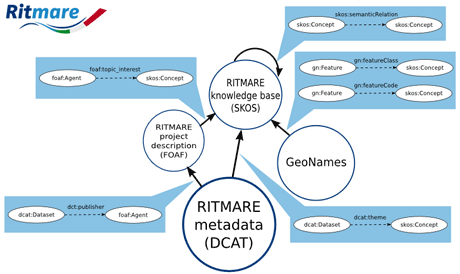by Cristiano Fugazza, Alessandro Oggioni and Paola Carrara
The RITMARE (la Ricerca ITaliana per il MARE – Italian Research for the sea) Flagship Project is one of the National Research Programmes funded by the Italian Ministry of University and Research. Its goal is the interdisciplinary integration of national marine research. In order to design a flexible Spatial Data Infrastructure (SDI) that adapts to the audience's specificities, the necessary context information is drawn from existing RDF-based schemata and sources. This enables semantics-aware profiling of end-users and resources, thus allowing their provision as Linked Open Data.
RITMARE includes public research bodies, inter-university consortia and private companies involved in marine research. The project's objectives are:
To support integrated policies for environmental protection (the health of the sea);
To facilitate sustainable use of resources (the sea as a system of production);
To implement a strategy of prevention and mitigation of natural impacts (the sea as a risk factor).
RITMARE is organized into seven sub-projects (SPs); SP7 is building an interoperable infrastructure for the Observation Network and Marine Data [1]. The infrastructure enables coordination and sharing of data, processes and information among all sub-projects. Harmonizing the practices and technologies already in use by the thousands of researchers within the RITMARE scientific community calls for the integration of heterogeneous data, metadata, workflows, and requirements.
Traditional online access with generic tools for all users does little to support friendly collaboration among researchers or their interaction needs. The RITMARE infrastructure is improving the interoperability, interdisciplinarity, and usability features via semantic tools tailored to the habits, skills and needs of researchers.
Expressing context information as RDF
In accordance with Italian legislation regarding Liked Open Data (LOD) [2], we have built an RDF knowledge base to ground the aforementioned semantic tools. It is composed of:
- Categorization of researchers, research institutes and the project's internal organization as Friend Of A Friend (FOAF) data structures (around 1,800 entities);
- Features relating to Italy or the Mediterranean Sea from the GeoNames ontology (around 40,000 entities);
- Observation parameters and measuring units from the British Oceanographic Data Centre (BODC) vocabulary repository, expressed as Simple Knowledge Organisation System (SKOS) concepts (around 30,000 entities);
- The research domains associated with the project, code lists and thesauri expressed as SKOS data structures (around 300 entities).
These data structures allow for semanatics-aware metadata descriptions in the Data Catalog Vocabulary (DCAT) format. In order to build a coherent structure from context information, these domains have been interconnected (see Figure 1):
- FOAF entities are related to SKOS concepts;
- Heterogeneous SKOS thesauri are aligned;
- DCAT metadata items reference entities from the above data structures and from the gazetteer.

The intended outcome is a repository of metadata from the heterogeneous, peripheral nodes of the RITMARE research network and the capacity for RDF-based metadata discovery.
Building a novel SDI user experience
One of the goals in the development of the RITMARE infrastructure is to provide the end-user with advanced functionalities on both the front- and back-end sides. Another main goal, building operating capacity by the providers of data and services, is beyond the scope of this article.
Front-end functionality includes user profiling, which allows for the creation of a customized user interface by relating users' FOAF descriptors to the SKOS concepts expressing research areas (top-left corner of Figure 1). The latter are associated with widgets in the interface by means of a matrix describing the appropriateness of a specific widget to a given research area. The layout of the interface can then be arranged according to a list of widgets ordered by relevance to the specific user.
By relating research areas to the entities referred to in metadata items, such as keywords, observation parameters and measuring units (bottom part of the picture), it is then possible to populate widgets with content that is tailored to the user's profile (e.g., datasets and services applicable to the user’s research area). Also, recourse to a gazetteer for expressing geographic locations simplifies discovery by reducing the need for a map.
On the back-end side, the architecture comprises collaboration tools for supporting activities that are not directly related to the discovery of resources but that, nevertheless, constitute essential phases in data production (e.g., the management of field work). Once users start enriching their profile data (even by simply using the infrastructure), the user experience should slowly but steadily converge to the user's expectations.
Acknowledgement
The activities described in this paper have been funded by the Italian Flagship Project RITMARE.
Links:
RITMARE Flagship Project: http://www.ritmare.it
Data Catalog Vocabulary (DCAT): http://www.w3.org/TR/vocab-dcat/
BODC webservices: http://seadatanet.maris2.nl/v_bodc_vocab/welcome.aspx
References:
[1] P. Carrara et al.: “An interoperable infrastructure for the Italian Marine Research”, IMDIS 2013
[2] Commissione di Coordinamento SPC: “Linee guida per l’interoperabilità semantica attraverso i Linked Open Data”, 2013
Please contact:
Cristiano Fugazza, CNR-IREA, Italy
E-mail:











